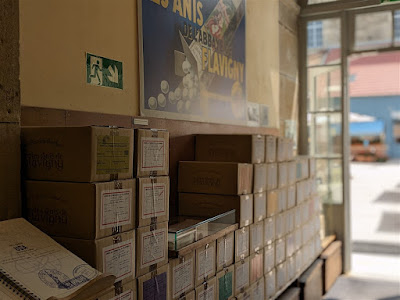Les anis de Flavigny, the very famous little French mint, has been produced in Flavigny since at least 1591. Only one producer remains, however, the Troubat family, but its factory, with 25 employees, is open to the public, and much of the ground floor is devoted to the history of the candy and its making. Anise is one of my favorite flavors, although I prefer it in liquid form--Pernod, Ricard, etc.--and Vicki is always open to candy stores, so...
 |
You could walk right by the place never suspecting anything
more than the neighborhood candy shop |
 |
Yet, beyond the candy shop are room after room of
displays on the candy, its making, history, importance
in French culture, etc. |
 |
The process, called dragee, involves coating a single
anise seed with a sugar syrup successively over 15
days...above are examples from various days of coating |
 |
| Video presentations in various rooms |
 |
| Bonbons of our childhood |
 |
Anise is not the only flavor nowadays...among ingredients of other
flavors |
 |
| As in a perfumery, squeeze the bulb and you get a whiff of aroma |
 |
| Packaging; historically |
 |
| Famous client department |
 |
| Can't get more famous than this |
 |
| Used to carry the royal Anis de Flavigny in a little round like this |
 |
| Easy to miss! Free samples! |
 |
| Plunk the magic twanger and a mint pops out |
 |
| Walking around by the factory, with its 25 employees |
 |
| Classroom with old candy-making devices |
 |
| I don't think they're into sugar-free yet |
 |
| Sweet! |




























































